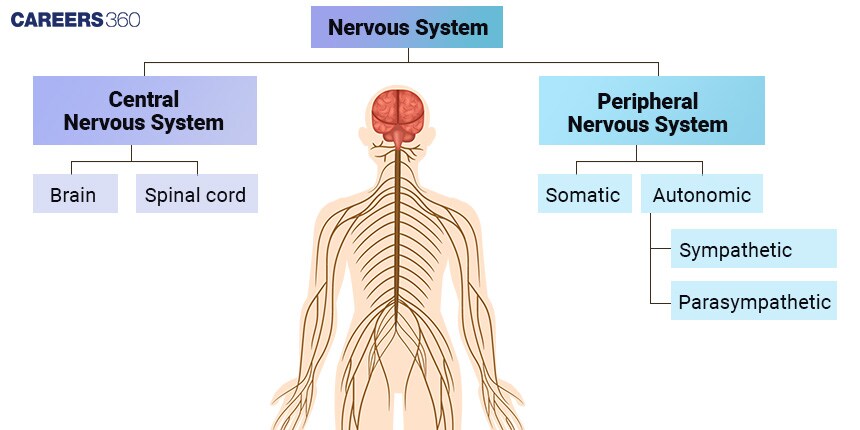Peripheral Nervous System: Definition, Parts, Functions, Disorders
The Peripheral Nervous System (PNS) connects the central nervous system to the rest of the body, facilitating communication between the brain, spinal cord, and peripheral organs. It consists of nerves and ganglia that control voluntary and involuntary actions. In this article, the definition of the peripheral nervous system (PNS), components of the peripheral nervous system, divisions of the peripheral nervous system, function of the peripheral nervous system, disorders of the peripheral nervous system and diagnostic methods for PNS disorders are discussed. The peripheral Nervous System is a topic of the chapter Neural Control And Coordination in Biology.
This Story also Contains
- Definition of the Peripheral Nervous System (PNS)
- Components of the Peripheral Nervous System
- Divisions of the Peripheral Nervous System
- Function of the Peripheral Nervous System
- Disorders of the Peripheral Nervous System
- Diagnostic Methods for PNS Disorders

Definition of the Peripheral Nervous System (PNS)
The Peripheral Nervous System is the nervous system that exists outside the brain and spinal cord. It acts as the middle man between the Central Nervous System and the limbs and organs, transmitting impulses necessary for action, voluntary and involuntary, therefore, sustaining the overall functioning of the body.
Components of the Peripheral Nervous System
It comprises nerves, ganglia, and their protective and supporting connective tissue coverings respectively.
Nerves
Groups of axons are wrapped by connective tissue that transmit signals between the CNS and the periphery.
Types Of Nerves
Sensory Nerves: Carry sensory information from receptors to the CNS.
Motor Nerves: Transmit motor commands from the CNS to muscles and glands.
Mixed Nerves: Contain both sensory and motor fibres, thus capable of transmitting signals in both directions.
Ganglia
Sensory (Dorsal Root Ganglia): Contains cell bodies of sensory neurons.
Autonomic Ganglia: Contains cell bodies of neurons in the autonomic nervous system.
Connective Tissue Coverings
Endoneurium: Surrounds individual nerve fibres (axons).
Perineurium: Encloses bundles of nerve fibres (fascicles).
Epineurium: Encases the entire nerve, providing protection and support.

Also Read-
Divisions of the Peripheral Nervous System
The PNS is divided into the somatic and autonomic nervous systems, each with distinct functions.
Somatic Nervous System:
Spinal Nerves: 31 pairs that emerge from the spinal cord.
Cranial Nerves: 12 pairs that emerge directly from the brain.
Role in Voluntary Movements: Controls skeletal muscle contractions and mediates conscious movements.
Autonomic Nervous System:
Sympathetic Nervous System: Prepares the body for 'fight or flight' responses.
Parasympathetic Nervous System: Promotes 'rest and digest' activities.
Regulates involuntary functions such as heart rate, digestion, and respiratory rate.
Function of the Peripheral Nervous System
The PNS is essential for reflex actions and the transmission of nerve impulses.
Reflex Arc
Examples of Reflex actions are knee-jerk reflex and withdrawal reflex.
Transmission of Nerve Impulses
Involves the movement of sodium and potassium ions across the neuron membrane, generating an electrical impulse.
Neurotransmitters are released from the axon terminal of one neuron and bind to receptors on the dendrite of another neuron, facilitating signal transmission.
Disorders of the Peripheral Nervous System
Several conditions can affect the PNS, leading to various symptoms and requiring different treatments.
Peripheral Neuropathy
Caused by diabetes, infections, and injuries; symptoms include numbness, tingling, and pain in the affected area.
Treatment Includes medications, physical therapy, and addressing underlying causes.
Guillain-Barré Syndrome
An autoimmune disorder is often triggered by an infection, leading to muscle weakness and paralysis.
Treatment includes Plasmapheresis, immunoglobulin therapy, and supportive care.
Carpal Tunnel Syndrome
Compression of the median nerve, causing pain and numbness in the hand.
Bell’s Palsy
Sudden weakness or paralysis of facial muscles, usually temporary.
Diagnostic Methods for PNS Disorders
Accurate diagnosis is crucial for effective treatment of PNS disorders.
Electromyography (EMG)
Nerve Conduction Studies (NCS)
MRI and CT Scans
Also Read-
Recommended Video On Peripheral Nervous System
Frequently Asked Questions (FAQs)
The PNS is that part of the nervous system which includes nerves and ganglia outside the brain and spinal cord.
The PNS connects the central nervous system with limbs and organs, allowing sensory and motor functions.
The somatic nervous system controls, which are voluntary movements, while the autonomic nervous system is in control of involuntary functions.
It is a secondary effect of diabetes, infections and injury; its management involves medications, physical therapy and the treatment of underlying illnesses.
Nerve conduction studies quantify the rate of travel and the amplitude of electrical impulses in nerves. The tests are done for diagnostic purposes within the peripheral nervous system.